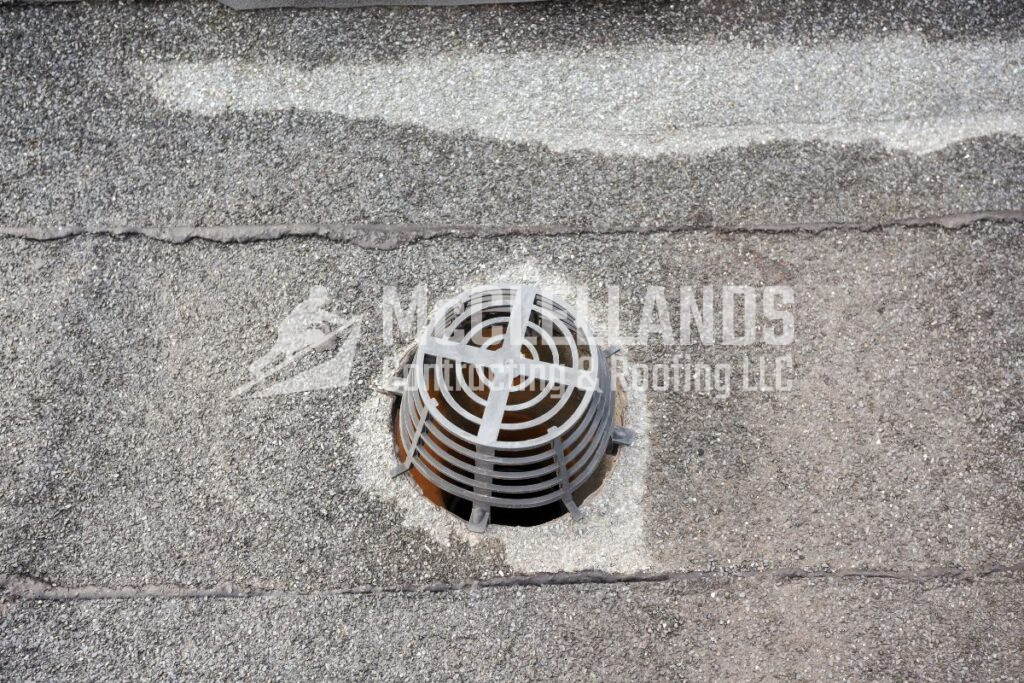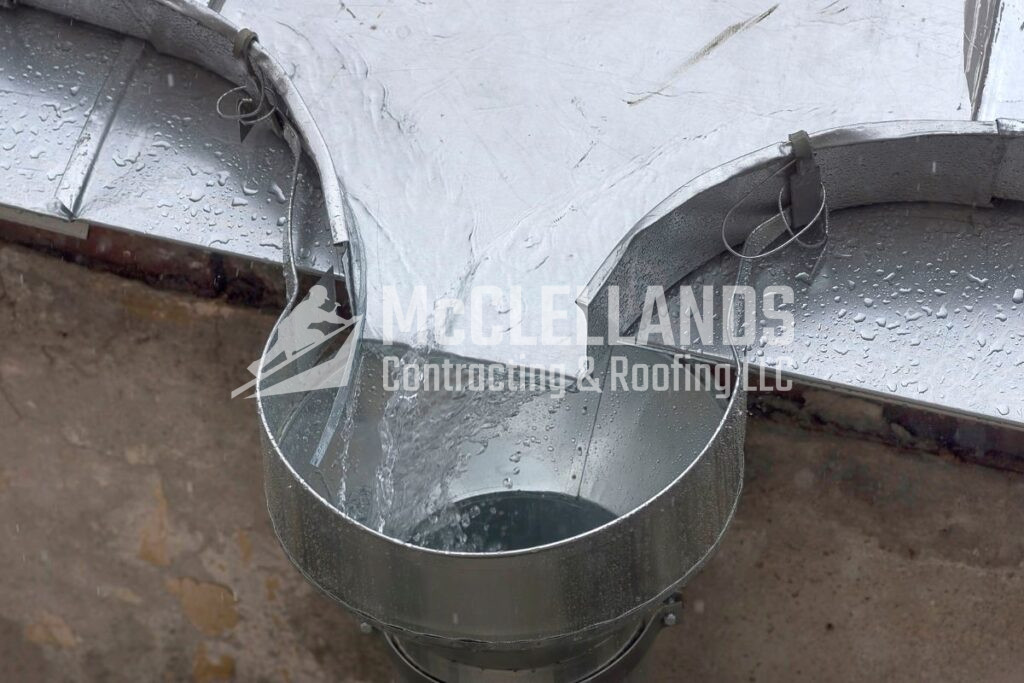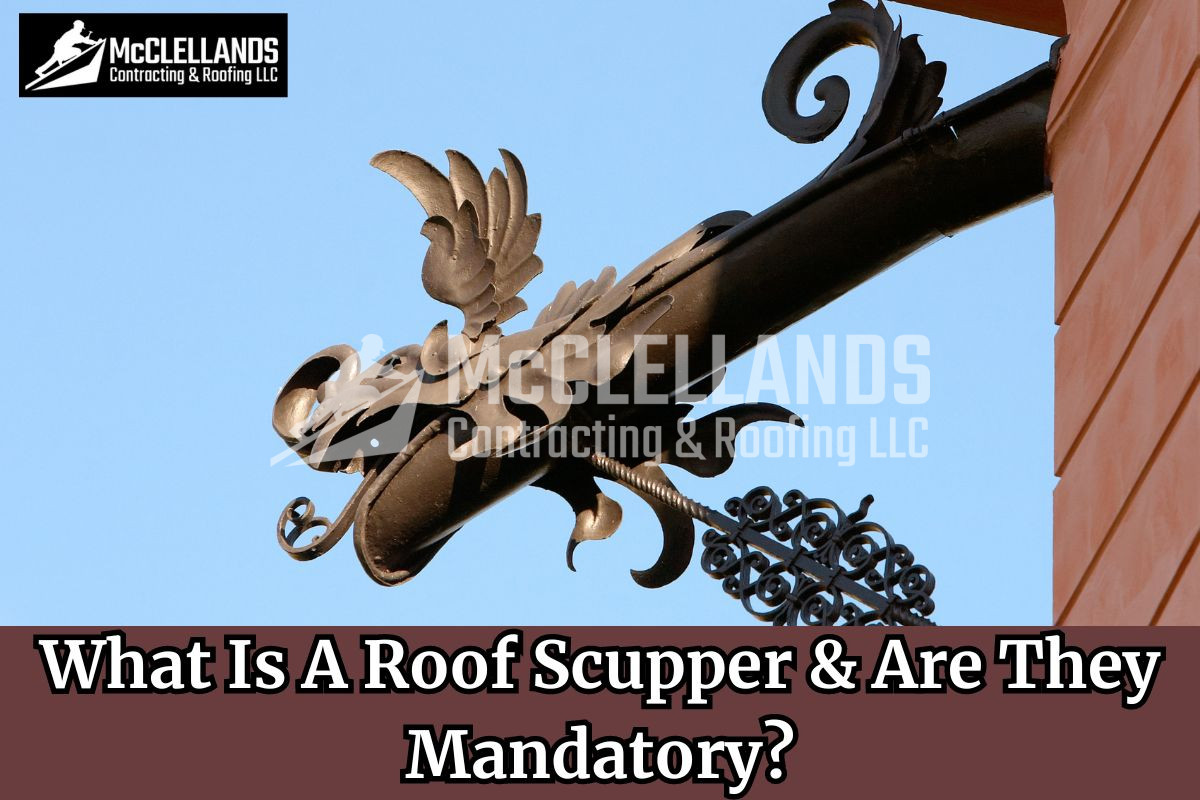Roof scuppers are effective at helping flat roofs that are prone to water ponding and leaks. A roof scupper is a crucial component that helps prevent costly water damage by allowing excess water to drain off the roof. But are roof scuppers mandatory features, or just optional?
We will be answering your question along with the following in this blog post
- What is a roof scupper?
- Are there building codes regarding roof scuppers?
- How do you install a scupper on a flat or low-pitched roof?
- How do you fix a leaking roof scupper?
- How do you maintain a roof scupper?
What Is A Roof Scupper?
A roof scupper is among the important parts of a roof, especially for low-pitched and flat roofs. A scupper is an opening or hole along the roof’s edge. It allows water collected on the roof’s surface to flow through the scupper and away from the roof.
Scuppers are important because if water is allowed to pool on a flat roof, it could cause leaks and damage the roof over time. On some roofs, multiple scuppers are spaced out along the edges to ensure there is enough drainage for all areas of the roof.
The scupper openings are usually lined with a metal material like copper or aluminum. This helps prevent any cracking or crumbling around the drainage hole over time. The scuppers connect to downspouts or drain pipes that carry the water down and away from the building’s foundation. Overall, roof scuppers prevent the risk of water ponding on your roofs.
Does A Flat Roof Need Drainage?

Yes, definitely, a flat roof needs a proper drainage system, as flat roofs are generally susceptible to water ponding on their surface. Ponding water is one of the common roof problems that can lead to the deterioration of other roofing materials.
What Are The Different Types Of Roof Scuppers?
There are a couple of types of roof scuppers available on the market, but here are two different designs:
#1 Through-Wall Scuppers
Through-wall scuppers are openings or holes that are made in the walls of a building. These roof scuppers have a straightforward design, with the purpose of allowing water out from the roof or other elevated surfaces. They are usually made of metal or plastic pipes that go through the wall, with one end sticking out on the outside of the building.
When it rains or snows, the water collects on the roof or other raised areas, but instead of letting the water pool up and potentially lead to leaks or damage, the through-wall scuppers provide a pathway for the water to flow out and drain away from the building.
#2 Channel Roof Scuppers
Channel roof scuppers are similar to through-wall scuppers, but they are designed differently. Instead of being pipes that go through the wall, they are open channels or troughs built into the roof itself.
These channels run along the edge of the roof and have openings or holes at regular intervals. When water collects on the roof, it flows into the channels and then drains out through the openings or holes.
Does The Building Code In Pennsylvania Require A Roof Scupper?
According to the building codes in Pennsylvania, roof scuppers or extra drains are needed for roofs with edges that could hold water if the main drains get blocked. These extra drains or scuppers have to be installed and sized according to rules in the International Plumbing Code.
Regarding scuppers specifically, the rules say that the number, size, location, and height of the scuppers must be planned to stop water from collecting and becoming deeper than the roof can handle. As a general rule of thumb, scuppers need to have an opening at least four inches wide.
How Do You Install A Scupper On A Flat Or Low-Pitched Roof?

Materials Required
- Roof scupper
- Roofing membrane
- Flashing
- Roofing nails
- Roofing sealant or mastic
- Saw or cutting tool
- Measuring tape
- Level
You need to follow certain steps to install a scupper on a flat or low-pitched roof. However, if you don’t have any experience working on your roof, you should hire an expert to ensure a safe and flawless installation.
Step 1. Locate the lowest points or areas where water collects on the roof and mark these spots for scupper installation.
Step 2. Cut an opening slightly larger than the scupper’s outer dimensions using a saw or cutting tool through the roof membrane/deck.
Step 3. Place the scupper into the opening, ensuring it is level and properly aligned. Secure any flanges/bases to the roof deck per the manufacturer’s instructions.
Step 4. Apply a good amount of roofing sealant or mastic around the edges of the scupper to create a watertight seal with the roof membrane.
Step 5. Install metal flashing or a liquid-applied flashing membrane around the scupper to prevent water seepage underneath.
Step 6. If required, connect the scupper’s outlet to a downspout or drainage system to direct water flow away from the building.
Step 7. Test the installed scupper by pouring water onto the roof area to ensure proper drainage without leaks or backups.
What Are The Challenges With Roof Scuppers?
Roof scuppers are considered a great drainage system for flat roofs, despite also having certain limitations.
• The size of the scuppers you install is really important. Small scuppers will channel the water slower than the large scuppers.
• Leaves and trash can clog the scuppers, leading to water ponding on your roof during rain. Regular inspection and clean-up can help avoid this issue.
• Snow can block the roof scuppers. This slows down the water drainage process, increasing the risk of leaks.
• Properly installing the roof scuppers is very important. Improper installation can increase the chance of leaks occurring.
How To Fix A Leaking Roof Scupper
When you start noticing that the roof scuppers are leaking, you need to find out what’s causing it to occur. Some causes include holes in your roof scupper, failed caulk, or debris buildup in the scupper.
To fix a leaking roof scupper, you’ll first need to identify the main reason for the issue occurring. Clear any debris that may be clogging the scupper and inspect it closely for cracks, holes, or separation from the roofing membrane. If the scupper itself is damaged, it may need to be replaced entirely.
For smaller holes or cracks, you can use a sealant designed for roof applications to patch it up. If the caulking or mesh around the scupper has failed, you’ll need to remove any old caulk and reapply it, installing new mesh reinforcement along with it. Proper sealing where the scupper meets the roofing membrane is also crucial to prevent future leaks.
A routine roof inspection by experts can help identify these minor issues before they cause the roofing materials to deteriorate.
Maintenance Tips For Roof Scuppers
Maintenance plays an important role in the performance of each part of your home. Here are some tips to maintain the durability and functionality of the roof scuppers on your building.
- Regularly cleaning and inspecting roof scuppers is important to make sure there is the right amount of drainage, and prevent any further damage to the roof. This includes checking for blockages, rust, and proper water flow to ensure water is directed away from the building.
- Clean out leaves and sticks. These can pile up fast, especially in the fall. Don’t let them sit there as they can cause water to back up onto your roof.
- Sealant can wear out over time due to the sun and other forms of weather damage. Look for any spots where it’s peeling or cracking, and apply new sealant if needed.
- In cold places, clear out ice and snow. These can block scuppers in winter. Be careful when removing ice so you don’t damage the scupper.
Call McClellands Contracting And Roofing For A Professional Roof Replacement In Pittsburgh, PA
If you are looking for a reliable roofing partner to replace your flat roof in Pittsburgh, PA, and the surrounding areas, then we are here to assist you!
At McClellands Contracting and Roofing, we have dedicated teams of expert roofers who can repair, install, or replace your roof. Our experts stick to the industry’s best practices and only use high-quality materials to ensure a flawless finish. With our commitment to delivering the best roofing solutions, you can count on us as your trusted roofing partner. To learn more about us, feel free to call us at (412) 3353-5660.

